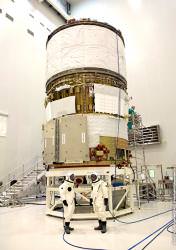The International Space Station (ISS) depends on regular deliveries of food, air and water, as well as equipment and spare parts to keep the station and its occupants happy and in peak operating condition. Of course, the space shuttle brings supplies on its visits for construction and crew exchange missions, and the Russian Progress spacecraft faithfully brings supplies and equipment to the station approximately every six months. But beginning in February 2008 the ISS will have a new supply ship: Europe’s Automated Transfer Vehicle (ATV). The first of seven planned ships, known as the “Jules Verne,” is currently undergoing fueling to ready the craft for its journey to the space station. Launch is tentatively scheduled for February 22.
The ATV pressurized cargo carrier is based on the Italian-built Multi-Purpose Logistics Module (MPLM), (aka Leonardo, Donatello and Raffaello) which has already been carried to the station via the space shuttle as a “space barge,” transporting equipment to and from the station. The ATV, which is equipped with its own propulsion and navigation systems combines full automatic capabilities of an unmanned vehicle with human spacecraft safety requirements. Its mission in space will resemble the combination of a tugboat and a river barge.
Every 12 months or so, the ATV will haul 7.5 tons of cargo to the Station 400 km above the Earth. The ATV will launch on board a Arianne 5 rocket from Kourou, French Guiana. An automatic navigation system will guide the ATV on a rendezvous trajectory towards ISS, to automatically dock with the station’s Russian service module. The ATV will remain docked to the station as a pressurized “waste basket” for up to six months until its final mission: a fiery one-way trip into the Earth’s atmosphere to dispose of up to 6.5 tons of station waste.
The ATV is a cylinder 10.3 meters long and 4.5 meters in diameter. The exterior is covered with an insulating foil layer on top of anti-meteorite Whipple Shields. The X-shaped extended solar arrays look like a metallic blue wings. Inside, the ATV consists of two modules, the propulsion spacecraft and the integrated cargo carrier which docks with the ISS.
The ATV’s will become especially important during the time period between after the shuttles are retired and before the next generation of US space craft, can bring supplies and crew to the station. The ESA also sees the ATVs as a way for Europe to pay its share in ISS running costs. Depending on the operational lifetime of the Space Station, ESA will build at least 7 ATVs.
Original News Source: ESA Press Release


6.5 tonnes of rubbish to be burnt up in the atmosphere, this is cosmic littering, does the USA have a Resource consent ( or simlier) for this POLLUTION? What about carbon credits?
Why not leave the rubbish up there in the ATV, some future space rat may mine it or even live there?
I CERTAINLY HOPE THIS IS REUSABLE. THE WAY THE ARTICLE READS, THE ATV WILL MAKE ONE TRIP TO THE ISS, COLLECT 6 MONTHS OF GARBAGE OVER A PERIOD OF 6 MONTHS, AND THEN BURN UP IN THE ATMOSPHERE OF EARTH.
sorry for the caps
You’re reading it right- it will burn up during its re-entry. The Russian Progress ships do the same. I don’t know if it creates enough pollution to warrant talks of carbon credits, but as this is an ESA spacecraft, I’d think it would be the EU that would need to answer that question.